LSBM306 - Strategy, Enterprise, and Innovation: Tesco PLC Case Study
VerifiedAdded on 2023/06/17
|10
|2643
|383
Report
AI Summary
This report provides a detailed analysis of Tesco PLC's strategy, enterprise, and innovation. It examines the internal resources and capabilities that give Tesco a competitive advantage, utilizing the VRIO framework and SWOT analysis. The report also analyzes the external environment using PESTLE analysis and Porter's Five Forces to assess the threats and opportunities Tesco faces. Key internal strengths include market share and innovative technology, while weaknesses involve leadership changes. Opportunities lie in online grocery sales growth, but threats arise from Brexit and competition. The analysis concludes that Tesco must effectively manage both micro and macro environments to sustain its competitive edge in the industry. Desklib offers a variety of similar reports and solved assignments for students.
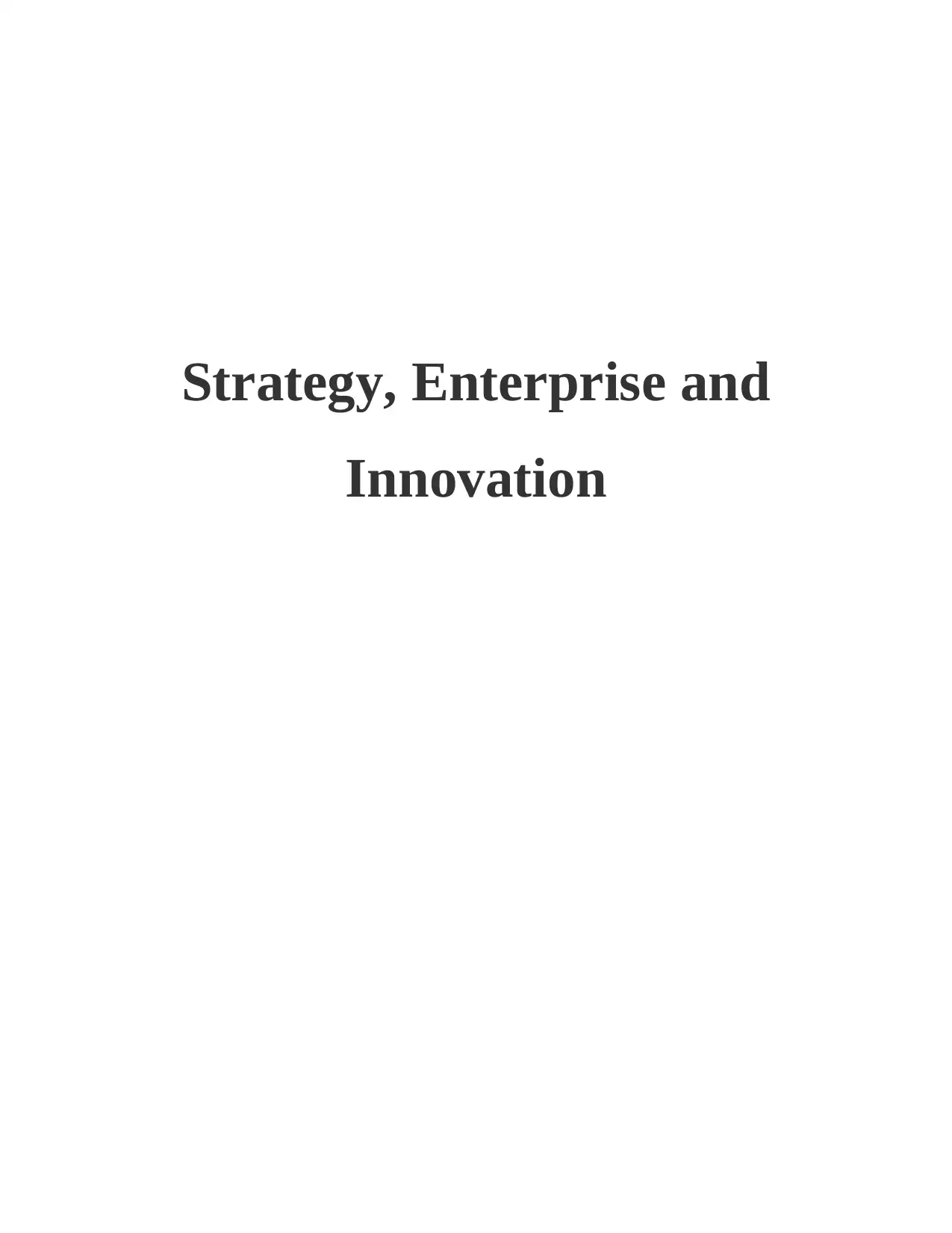
Strategy, Enterprise and
Innovation
Innovation
Paraphrase This Document
Need a fresh take? Get an instant paraphrase of this document with our AI Paraphraser
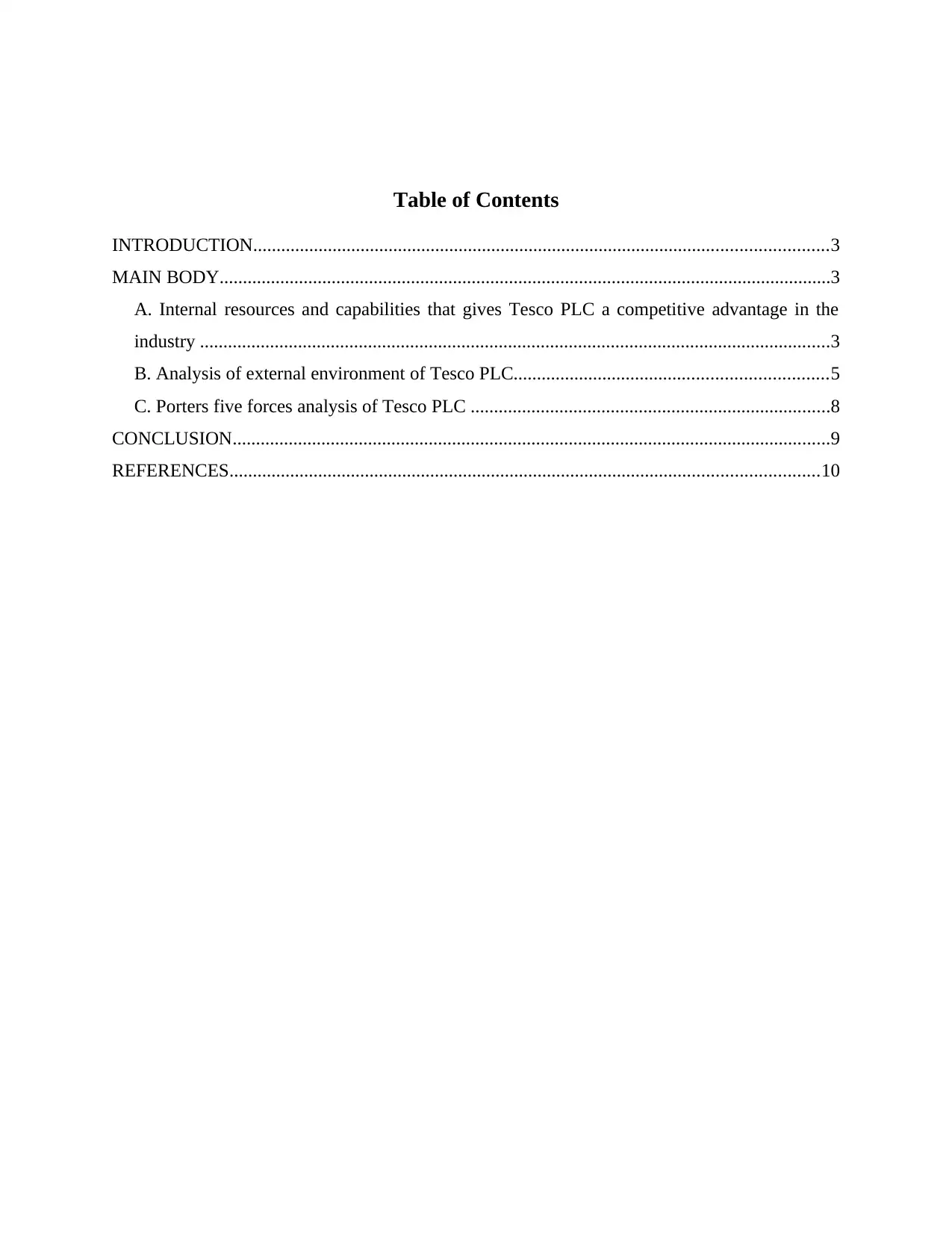
Table of Contents
INTRODUCTION...........................................................................................................................3
MAIN BODY...................................................................................................................................3
A. Internal resources and capabilities that gives Tesco PLC a competitive advantage in the
industry .......................................................................................................................................3
B. Analysis of external environment of Tesco PLC...................................................................5
C. Porters five forces analysis of Tesco PLC .............................................................................8
CONCLUSION................................................................................................................................9
REFERENCES..............................................................................................................................10
INTRODUCTION...........................................................................................................................3
MAIN BODY...................................................................................................................................3
A. Internal resources and capabilities that gives Tesco PLC a competitive advantage in the
industry .......................................................................................................................................3
B. Analysis of external environment of Tesco PLC...................................................................5
C. Porters five forces analysis of Tesco PLC .............................................................................8
CONCLUSION................................................................................................................................9
REFERENCES..............................................................................................................................10
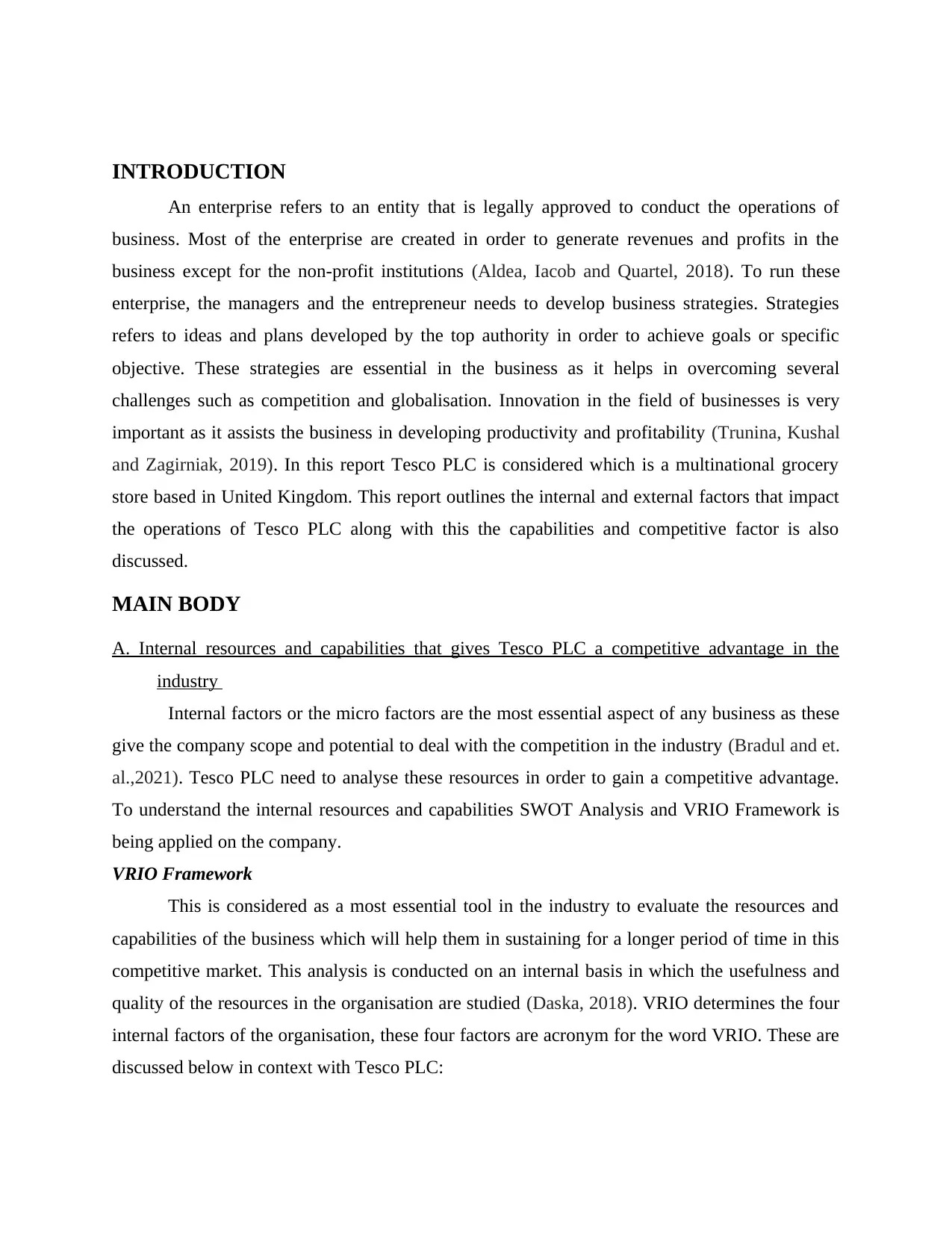
INTRODUCTION
An enterprise refers to an entity that is legally approved to conduct the operations of
business. Most of the enterprise are created in order to generate revenues and profits in the
business except for the non-profit institutions (Aldea, Iacob and Quartel, 2018). To run these
enterprise, the managers and the entrepreneur needs to develop business strategies. Strategies
refers to ideas and plans developed by the top authority in order to achieve goals or specific
objective. These strategies are essential in the business as it helps in overcoming several
challenges such as competition and globalisation. Innovation in the field of businesses is very
important as it assists the business in developing productivity and profitability (Trunina, Kushal
and Zagirniak, 2019). In this report Tesco PLC is considered which is a multinational grocery
store based in United Kingdom. This report outlines the internal and external factors that impact
the operations of Tesco PLC along with this the capabilities and competitive factor is also
discussed.
MAIN BODY
A. Internal resources and capabilities that gives Tesco PLC a competitive advantage in the
industry
Internal factors or the micro factors are the most essential aspect of any business as these
give the company scope and potential to deal with the competition in the industry (Bradul and et.
al.,2021). Tesco PLC need to analyse these resources in order to gain a competitive advantage.
To understand the internal resources and capabilities SWOT Analysis and VRIO Framework is
being applied on the company.
VRIO Framework
This is considered as a most essential tool in the industry to evaluate the resources and
capabilities of the business which will help them in sustaining for a longer period of time in this
competitive market. This analysis is conducted on an internal basis in which the usefulness and
quality of the resources in the organisation are studied (Daska, 2018). VRIO determines the four
internal factors of the organisation, these four factors are acronym for the word VRIO. These are
discussed below in context with Tesco PLC:
An enterprise refers to an entity that is legally approved to conduct the operations of
business. Most of the enterprise are created in order to generate revenues and profits in the
business except for the non-profit institutions (Aldea, Iacob and Quartel, 2018). To run these
enterprise, the managers and the entrepreneur needs to develop business strategies. Strategies
refers to ideas and plans developed by the top authority in order to achieve goals or specific
objective. These strategies are essential in the business as it helps in overcoming several
challenges such as competition and globalisation. Innovation in the field of businesses is very
important as it assists the business in developing productivity and profitability (Trunina, Kushal
and Zagirniak, 2019). In this report Tesco PLC is considered which is a multinational grocery
store based in United Kingdom. This report outlines the internal and external factors that impact
the operations of Tesco PLC along with this the capabilities and competitive factor is also
discussed.
MAIN BODY
A. Internal resources and capabilities that gives Tesco PLC a competitive advantage in the
industry
Internal factors or the micro factors are the most essential aspect of any business as these
give the company scope and potential to deal with the competition in the industry (Bradul and et.
al.,2021). Tesco PLC need to analyse these resources in order to gain a competitive advantage.
To understand the internal resources and capabilities SWOT Analysis and VRIO Framework is
being applied on the company.
VRIO Framework
This is considered as a most essential tool in the industry to evaluate the resources and
capabilities of the business which will help them in sustaining for a longer period of time in this
competitive market. This analysis is conducted on an internal basis in which the usefulness and
quality of the resources in the organisation are studied (Daska, 2018). VRIO determines the four
internal factors of the organisation, these four factors are acronym for the word VRIO. These are
discussed below in context with Tesco PLC:
⊘ This is a preview!⊘
Do you want full access?
Subscribe today to unlock all pages.

Trusted by 1+ million students worldwide
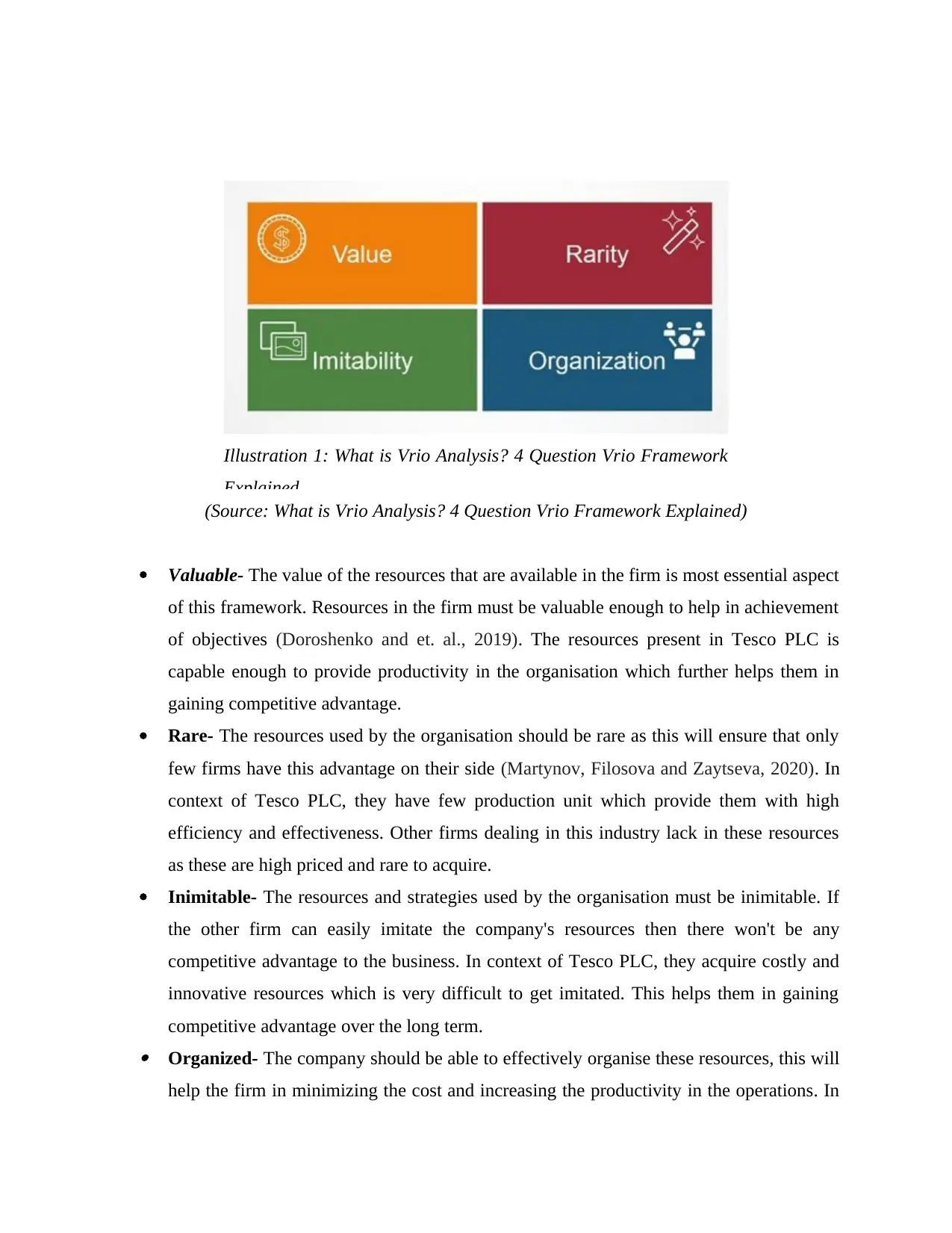
(Source: What is Vrio Analysis? 4 Question Vrio Framework Explained)
Valuable- The value of the resources that are available in the firm is most essential aspect
of this framework. Resources in the firm must be valuable enough to help in achievement
of objectives (Doroshenko and et. al., 2019). The resources present in Tesco PLC is
capable enough to provide productivity in the organisation which further helps them in
gaining competitive advantage.
Rare- The resources used by the organisation should be rare as this will ensure that only
few firms have this advantage on their side (Martynov, Filosova and Zaytseva, 2020). In
context of Tesco PLC, they have few production unit which provide them with high
efficiency and effectiveness. Other firms dealing in this industry lack in these resources
as these are high priced and rare to acquire.
Inimitable- The resources and strategies used by the organisation must be inimitable. If
the other firm can easily imitate the company's resources then there won't be any
competitive advantage to the business. In context of Tesco PLC, they acquire costly and
innovative resources which is very difficult to get imitated. This helps them in gaining
competitive advantage over the long term. Organized- The company should be able to effectively organise these resources, this will
help the firm in minimizing the cost and increasing the productivity in the operations. In
Illustration 1: What is Vrio Analysis? 4 Question Vrio Framework
Explained
Valuable- The value of the resources that are available in the firm is most essential aspect
of this framework. Resources in the firm must be valuable enough to help in achievement
of objectives (Doroshenko and et. al., 2019). The resources present in Tesco PLC is
capable enough to provide productivity in the organisation which further helps them in
gaining competitive advantage.
Rare- The resources used by the organisation should be rare as this will ensure that only
few firms have this advantage on their side (Martynov, Filosova and Zaytseva, 2020). In
context of Tesco PLC, they have few production unit which provide them with high
efficiency and effectiveness. Other firms dealing in this industry lack in these resources
as these are high priced and rare to acquire.
Inimitable- The resources and strategies used by the organisation must be inimitable. If
the other firm can easily imitate the company's resources then there won't be any
competitive advantage to the business. In context of Tesco PLC, they acquire costly and
innovative resources which is very difficult to get imitated. This helps them in gaining
competitive advantage over the long term. Organized- The company should be able to effectively organise these resources, this will
help the firm in minimizing the cost and increasing the productivity in the operations. In
Illustration 1: What is Vrio Analysis? 4 Question Vrio Framework
Explained
Paraphrase This Document
Need a fresh take? Get an instant paraphrase of this document with our AI Paraphraser
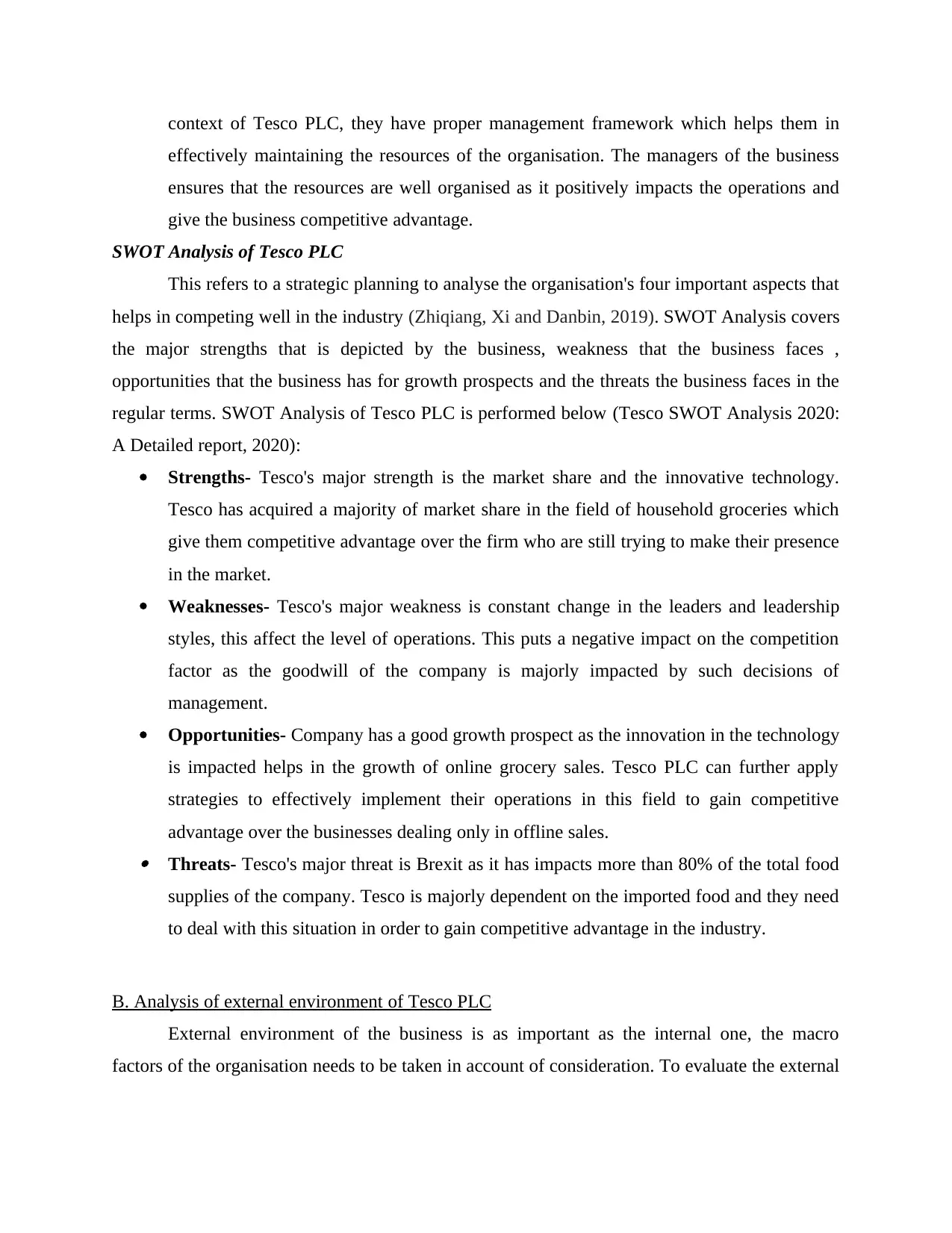
context of Tesco PLC, they have proper management framework which helps them in
effectively maintaining the resources of the organisation. The managers of the business
ensures that the resources are well organised as it positively impacts the operations and
give the business competitive advantage.
SWOT Analysis of Tesco PLC
This refers to a strategic planning to analyse the organisation's four important aspects that
helps in competing well in the industry (Zhiqiang, Xi and Danbin, 2019). SWOT Analysis covers
the major strengths that is depicted by the business, weakness that the business faces ,
opportunities that the business has for growth prospects and the threats the business faces in the
regular terms. SWOT Analysis of Tesco PLC is performed below (Tesco SWOT Analysis 2020:
A Detailed report, 2020):
Strengths- Tesco's major strength is the market share and the innovative technology.
Tesco has acquired a majority of market share in the field of household groceries which
give them competitive advantage over the firm who are still trying to make their presence
in the market.
Weaknesses- Tesco's major weakness is constant change in the leaders and leadership
styles, this affect the level of operations. This puts a negative impact on the competition
factor as the goodwill of the company is majorly impacted by such decisions of
management.
Opportunities- Company has a good growth prospect as the innovation in the technology
is impacted helps in the growth of online grocery sales. Tesco PLC can further apply
strategies to effectively implement their operations in this field to gain competitive
advantage over the businesses dealing only in offline sales. Threats- Tesco's major threat is Brexit as it has impacts more than 80% of the total food
supplies of the company. Tesco is majorly dependent on the imported food and they need
to deal with this situation in order to gain competitive advantage in the industry.
B. Analysis of external environment of Tesco PLC
External environment of the business is as important as the internal one, the macro
factors of the organisation needs to be taken in account of consideration. To evaluate the external
effectively maintaining the resources of the organisation. The managers of the business
ensures that the resources are well organised as it positively impacts the operations and
give the business competitive advantage.
SWOT Analysis of Tesco PLC
This refers to a strategic planning to analyse the organisation's four important aspects that
helps in competing well in the industry (Zhiqiang, Xi and Danbin, 2019). SWOT Analysis covers
the major strengths that is depicted by the business, weakness that the business faces ,
opportunities that the business has for growth prospects and the threats the business faces in the
regular terms. SWOT Analysis of Tesco PLC is performed below (Tesco SWOT Analysis 2020:
A Detailed report, 2020):
Strengths- Tesco's major strength is the market share and the innovative technology.
Tesco has acquired a majority of market share in the field of household groceries which
give them competitive advantage over the firm who are still trying to make their presence
in the market.
Weaknesses- Tesco's major weakness is constant change in the leaders and leadership
styles, this affect the level of operations. This puts a negative impact on the competition
factor as the goodwill of the company is majorly impacted by such decisions of
management.
Opportunities- Company has a good growth prospect as the innovation in the technology
is impacted helps in the growth of online grocery sales. Tesco PLC can further apply
strategies to effectively implement their operations in this field to gain competitive
advantage over the businesses dealing only in offline sales. Threats- Tesco's major threat is Brexit as it has impacts more than 80% of the total food
supplies of the company. Tesco is majorly dependent on the imported food and they need
to deal with this situation in order to gain competitive advantage in the industry.
B. Analysis of external environment of Tesco PLC
External environment of the business is as important as the internal one, the macro
factors of the organisation needs to be taken in account of consideration. To evaluate the external
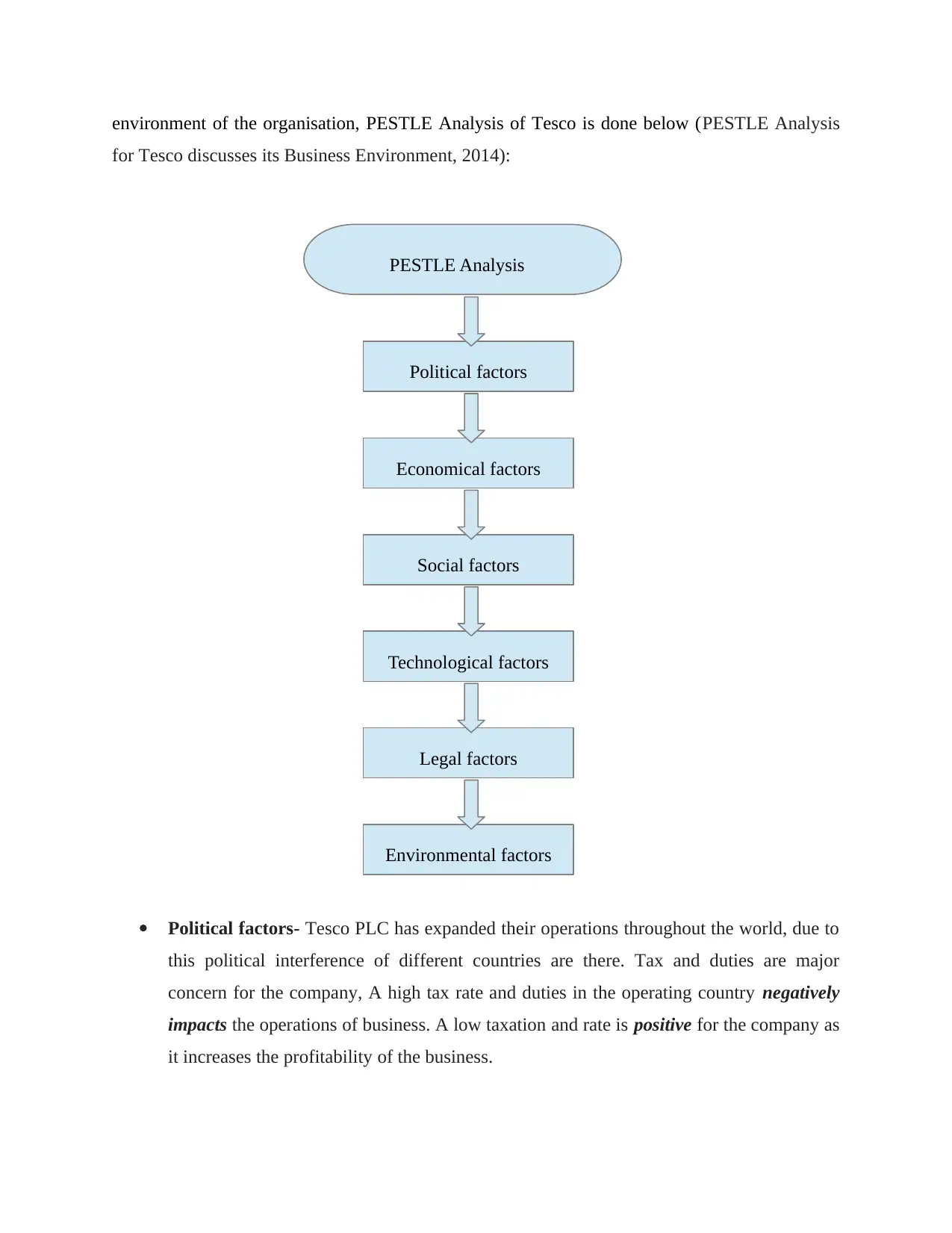
environment of the organisation, PESTLE Analysis of Tesco is done below (PESTLE Analysis
for Tesco discusses its Business Environment, 2014):
Political factors- Tesco PLC has expanded their operations throughout the world, due to
this political interference of different countries are there. Tax and duties are major
concern for the company, A high tax rate and duties in the operating country negatively
impacts the operations of business. A low taxation and rate is positive for the company as
it increases the profitability of the business.
PESTLE Analysis
Political factors
Economical factors
Social factors
Technological factors
Legal factors
Environmental factors
for Tesco discusses its Business Environment, 2014):
Political factors- Tesco PLC has expanded their operations throughout the world, due to
this political interference of different countries are there. Tax and duties are major
concern for the company, A high tax rate and duties in the operating country negatively
impacts the operations of business. A low taxation and rate is positive for the company as
it increases the profitability of the business.
PESTLE Analysis
Political factors
Economical factors
Social factors
Technological factors
Legal factors
Environmental factors
⊘ This is a preview!⊘
Do you want full access?
Subscribe today to unlock all pages.

Trusted by 1+ million students worldwide
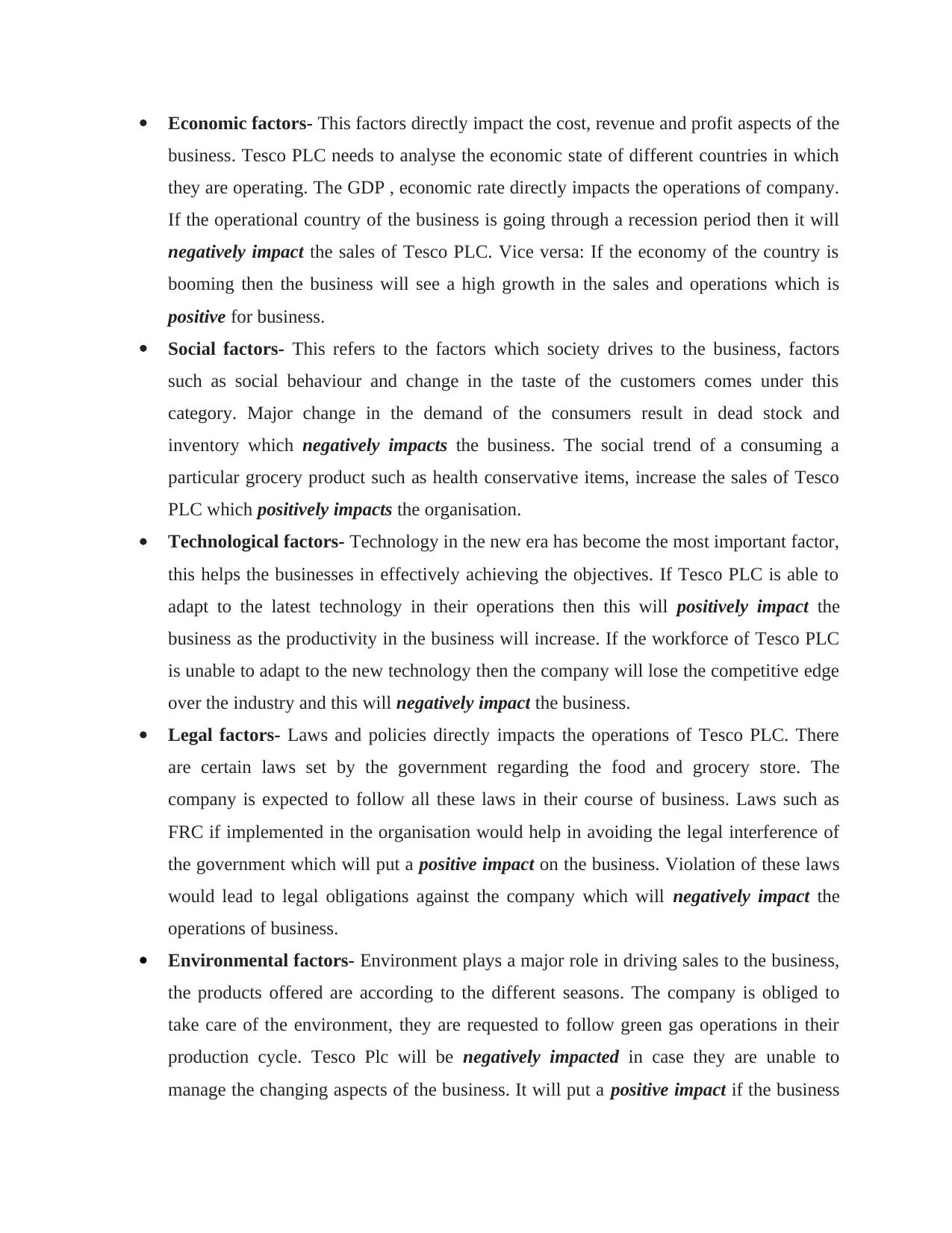
Economic factors- This factors directly impact the cost, revenue and profit aspects of the
business. Tesco PLC needs to analyse the economic state of different countries in which
they are operating. The GDP , economic rate directly impacts the operations of company.
If the operational country of the business is going through a recession period then it will
negatively impact the sales of Tesco PLC. Vice versa: If the economy of the country is
booming then the business will see a high growth in the sales and operations which is
positive for business.
Social factors- This refers to the factors which society drives to the business, factors
such as social behaviour and change in the taste of the customers comes under this
category. Major change in the demand of the consumers result in dead stock and
inventory which negatively impacts the business. The social trend of a consuming a
particular grocery product such as health conservative items, increase the sales of Tesco
PLC which positively impacts the organisation.
Technological factors- Technology in the new era has become the most important factor,
this helps the businesses in effectively achieving the objectives. If Tesco PLC is able to
adapt to the latest technology in their operations then this will positively impact the
business as the productivity in the business will increase. If the workforce of Tesco PLC
is unable to adapt to the new technology then the company will lose the competitive edge
over the industry and this will negatively impact the business.
Legal factors- Laws and policies directly impacts the operations of Tesco PLC. There
are certain laws set by the government regarding the food and grocery store. The
company is expected to follow all these laws in their course of business. Laws such as
FRC if implemented in the organisation would help in avoiding the legal interference of
the government which will put a positive impact on the business. Violation of these laws
would lead to legal obligations against the company which will negatively impact the
operations of business.
Environmental factors- Environment plays a major role in driving sales to the business,
the products offered are according to the different seasons. The company is obliged to
take care of the environment, they are requested to follow green gas operations in their
production cycle. Tesco Plc will be negatively impacted in case they are unable to
manage the changing aspects of the business. It will put a positive impact if the business
business. Tesco PLC needs to analyse the economic state of different countries in which
they are operating. The GDP , economic rate directly impacts the operations of company.
If the operational country of the business is going through a recession period then it will
negatively impact the sales of Tesco PLC. Vice versa: If the economy of the country is
booming then the business will see a high growth in the sales and operations which is
positive for business.
Social factors- This refers to the factors which society drives to the business, factors
such as social behaviour and change in the taste of the customers comes under this
category. Major change in the demand of the consumers result in dead stock and
inventory which negatively impacts the business. The social trend of a consuming a
particular grocery product such as health conservative items, increase the sales of Tesco
PLC which positively impacts the organisation.
Technological factors- Technology in the new era has become the most important factor,
this helps the businesses in effectively achieving the objectives. If Tesco PLC is able to
adapt to the latest technology in their operations then this will positively impact the
business as the productivity in the business will increase. If the workforce of Tesco PLC
is unable to adapt to the new technology then the company will lose the competitive edge
over the industry and this will negatively impact the business.
Legal factors- Laws and policies directly impacts the operations of Tesco PLC. There
are certain laws set by the government regarding the food and grocery store. The
company is expected to follow all these laws in their course of business. Laws such as
FRC if implemented in the organisation would help in avoiding the legal interference of
the government which will put a positive impact on the business. Violation of these laws
would lead to legal obligations against the company which will negatively impact the
operations of business.
Environmental factors- Environment plays a major role in driving sales to the business,
the products offered are according to the different seasons. The company is obliged to
take care of the environment, they are requested to follow green gas operations in their
production cycle. Tesco Plc will be negatively impacted in case they are unable to
manage the changing aspects of the business. It will put a positive impact if the business
Paraphrase This Document
Need a fresh take? Get an instant paraphrase of this document with our AI Paraphraser
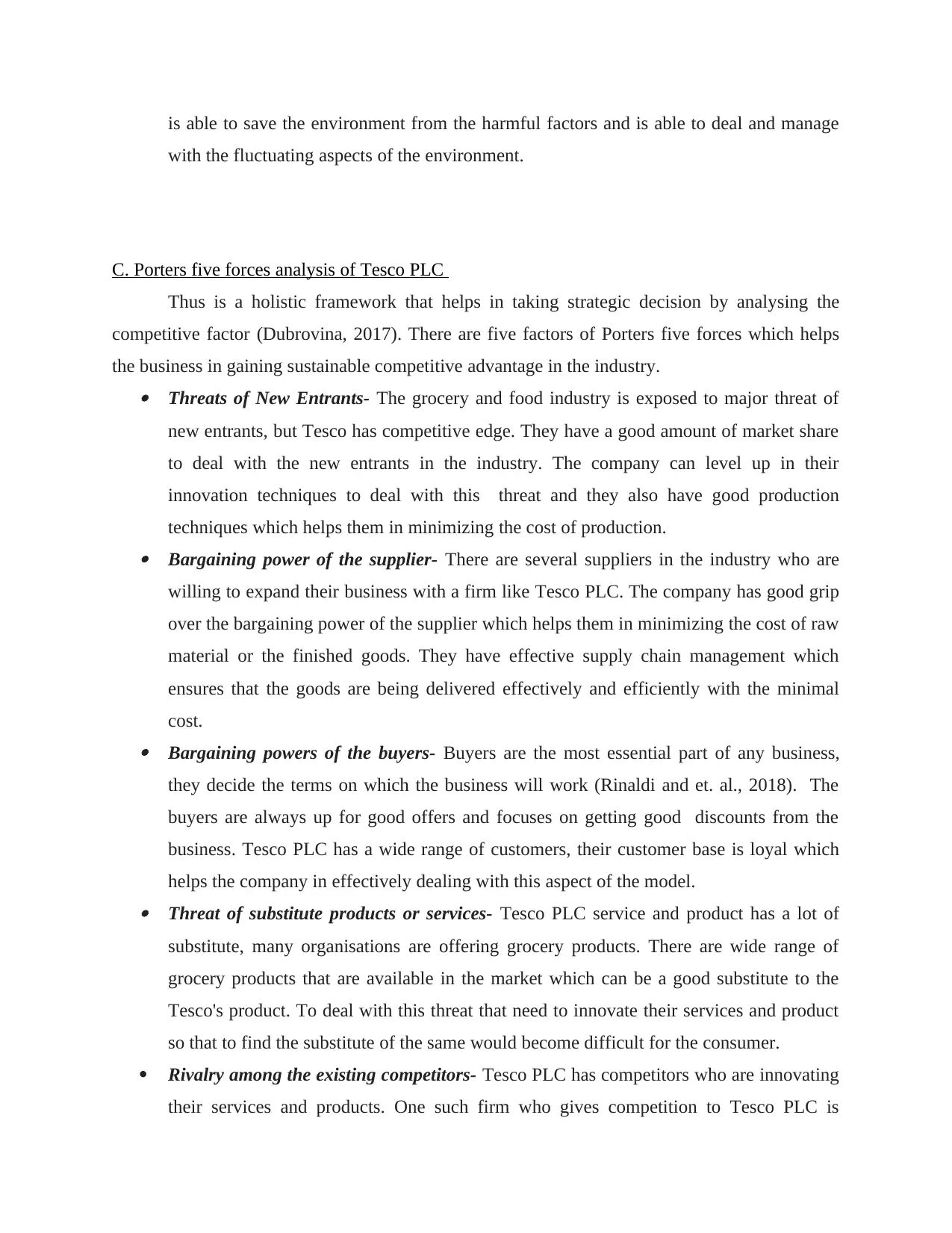
is able to save the environment from the harmful factors and is able to deal and manage
with the fluctuating aspects of the environment.
C. Porters five forces analysis of Tesco PLC
Thus is a holistic framework that helps in taking strategic decision by analysing the
competitive factor (Dubrovina, 2017). There are five factors of Porters five forces which helps
the business in gaining sustainable competitive advantage in the industry. Threats of New Entrants- The grocery and food industry is exposed to major threat of
new entrants, but Tesco has competitive edge. They have a good amount of market share
to deal with the new entrants in the industry. The company can level up in their
innovation techniques to deal with this threat and they also have good production
techniques which helps them in minimizing the cost of production. Bargaining power of the supplier- There are several suppliers in the industry who are
willing to expand their business with a firm like Tesco PLC. The company has good grip
over the bargaining power of the supplier which helps them in minimizing the cost of raw
material or the finished goods. They have effective supply chain management which
ensures that the goods are being delivered effectively and efficiently with the minimal
cost. Bargaining powers of the buyers- Buyers are the most essential part of any business,
they decide the terms on which the business will work (Rinaldi and et. al., 2018). The
buyers are always up for good offers and focuses on getting good discounts from the
business. Tesco PLC has a wide range of customers, their customer base is loyal which
helps the company in effectively dealing with this aspect of the model. Threat of substitute products or services- Tesco PLC service and product has a lot of
substitute, many organisations are offering grocery products. There are wide range of
grocery products that are available in the market which can be a good substitute to the
Tesco's product. To deal with this threat that need to innovate their services and product
so that to find the substitute of the same would become difficult for the consumer.
Rivalry among the existing competitors- Tesco PLC has competitors who are innovating
their services and products. One such firm who gives competition to Tesco PLC is
with the fluctuating aspects of the environment.
C. Porters five forces analysis of Tesco PLC
Thus is a holistic framework that helps in taking strategic decision by analysing the
competitive factor (Dubrovina, 2017). There are five factors of Porters five forces which helps
the business in gaining sustainable competitive advantage in the industry. Threats of New Entrants- The grocery and food industry is exposed to major threat of
new entrants, but Tesco has competitive edge. They have a good amount of market share
to deal with the new entrants in the industry. The company can level up in their
innovation techniques to deal with this threat and they also have good production
techniques which helps them in minimizing the cost of production. Bargaining power of the supplier- There are several suppliers in the industry who are
willing to expand their business with a firm like Tesco PLC. The company has good grip
over the bargaining power of the supplier which helps them in minimizing the cost of raw
material or the finished goods. They have effective supply chain management which
ensures that the goods are being delivered effectively and efficiently with the minimal
cost. Bargaining powers of the buyers- Buyers are the most essential part of any business,
they decide the terms on which the business will work (Rinaldi and et. al., 2018). The
buyers are always up for good offers and focuses on getting good discounts from the
business. Tesco PLC has a wide range of customers, their customer base is loyal which
helps the company in effectively dealing with this aspect of the model. Threat of substitute products or services- Tesco PLC service and product has a lot of
substitute, many organisations are offering grocery products. There are wide range of
grocery products that are available in the market which can be a good substitute to the
Tesco's product. To deal with this threat that need to innovate their services and product
so that to find the substitute of the same would become difficult for the consumer.
Rivalry among the existing competitors- Tesco PLC has competitors who are innovating
their services and products. One such firm who gives competition to Tesco PLC is
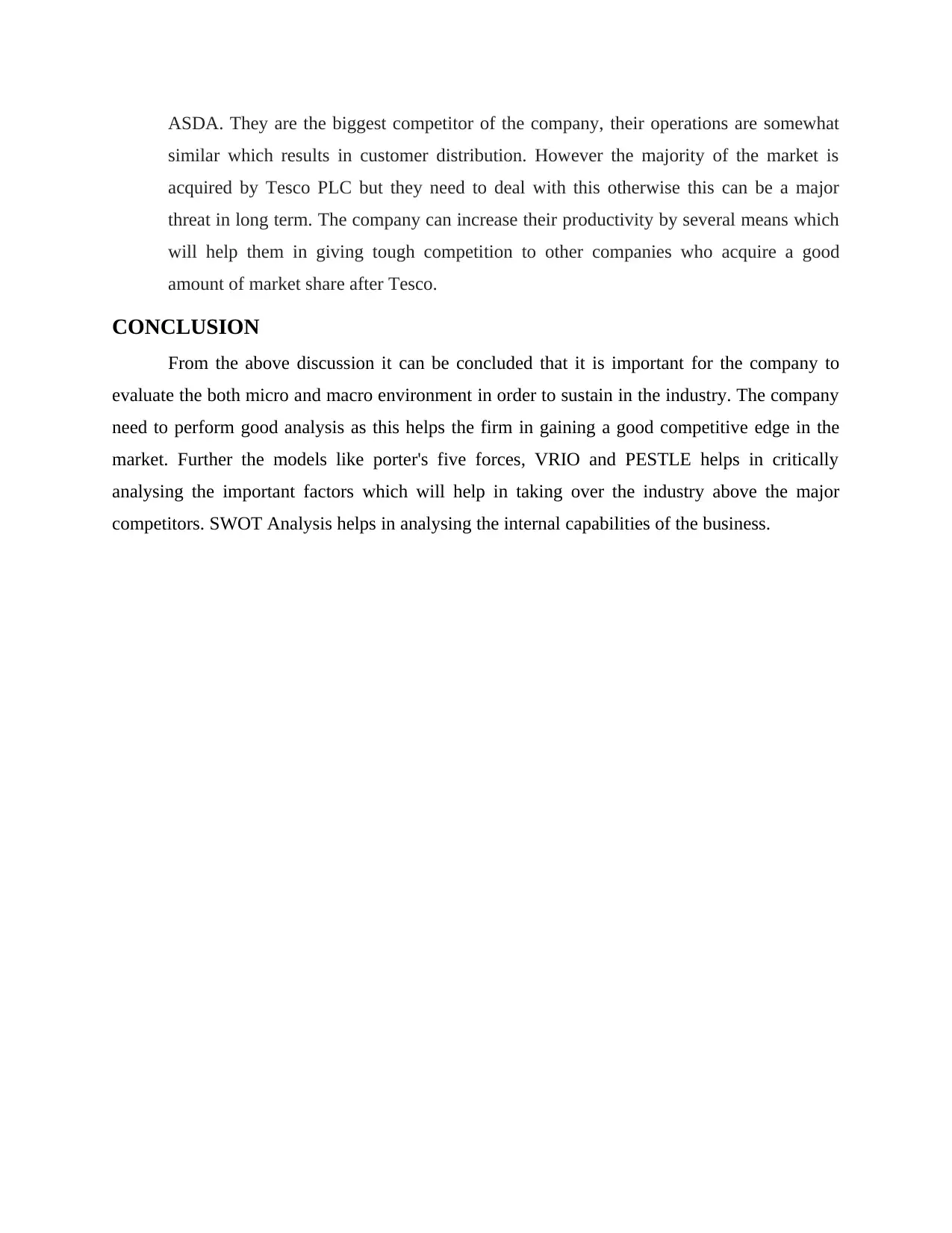
ASDA. They are the biggest competitor of the company, their operations are somewhat
similar which results in customer distribution. However the majority of the market is
acquired by Tesco PLC but they need to deal with this otherwise this can be a major
threat in long term. The company can increase their productivity by several means which
will help them in giving tough competition to other companies who acquire a good
amount of market share after Tesco.
CONCLUSION
From the above discussion it can be concluded that it is important for the company to
evaluate the both micro and macro environment in order to sustain in the industry. The company
need to perform good analysis as this helps the firm in gaining a good competitive edge in the
market. Further the models like porter's five forces, VRIO and PESTLE helps in critically
analysing the important factors which will help in taking over the industry above the major
competitors. SWOT Analysis helps in analysing the internal capabilities of the business.
similar which results in customer distribution. However the majority of the market is
acquired by Tesco PLC but they need to deal with this otherwise this can be a major
threat in long term. The company can increase their productivity by several means which
will help them in giving tough competition to other companies who acquire a good
amount of market share after Tesco.
CONCLUSION
From the above discussion it can be concluded that it is important for the company to
evaluate the both micro and macro environment in order to sustain in the industry. The company
need to perform good analysis as this helps the firm in gaining a good competitive edge in the
market. Further the models like porter's five forces, VRIO and PESTLE helps in critically
analysing the important factors which will help in taking over the industry above the major
competitors. SWOT Analysis helps in analysing the internal capabilities of the business.
⊘ This is a preview!⊘
Do you want full access?
Subscribe today to unlock all pages.

Trusted by 1+ million students worldwide
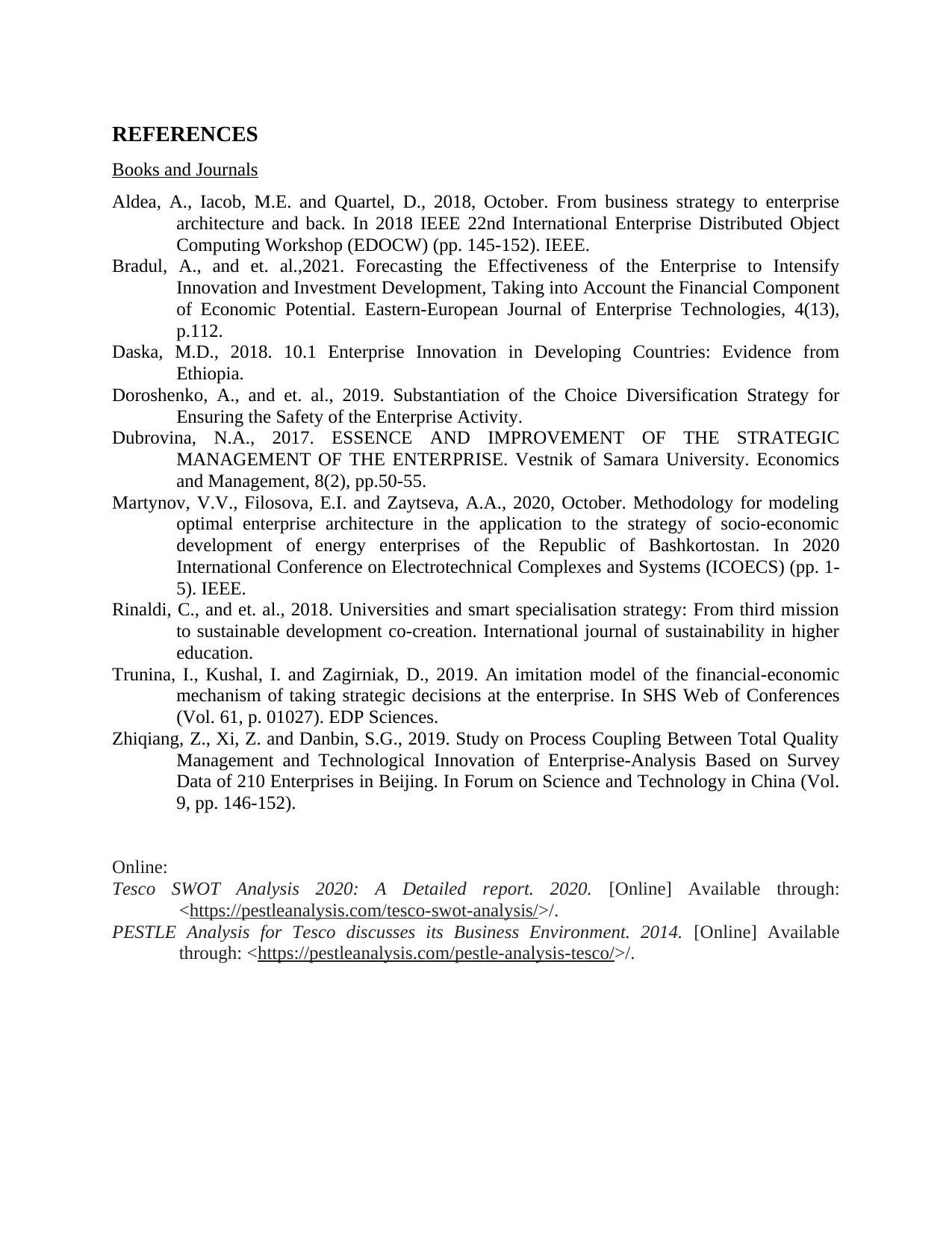
REFERENCES
Books and Journals
Aldea, A., Iacob, M.E. and Quartel, D., 2018, October. From business strategy to enterprise
architecture and back. In 2018 IEEE 22nd International Enterprise Distributed Object
Computing Workshop (EDOCW) (pp. 145-152). IEEE.
Bradul, A., and et. al.,2021. Forecasting the Effectiveness of the Enterprise to Intensify
Innovation and Investment Development, Taking into Account the Financial Component
of Economic Potential. Eastern-European Journal of Enterprise Technologies, 4(13),
p.112.
Daska, M.D., 2018. 10.1 Enterprise Innovation in Developing Countries: Evidence from
Ethiopia.
Doroshenko, A., and et. al., 2019. Substantiation of the Choice Diversification Strategy for
Ensuring the Safety of the Enterprise Activity.
Dubrovina, N.A., 2017. ESSENCE AND IMPROVEMENT OF THE STRATEGIC
MANAGEMENT OF THE ENTERPRISE. Vestnik of Samara University. Economics
and Management, 8(2), pp.50-55.
Martynov, V.V., Filosova, E.I. and Zaytseva, A.A., 2020, October. Methodology for modeling
optimal enterprise architecture in the application to the strategy of socio-economic
development of energy enterprises of the Republic of Bashkortostan. In 2020
International Conference on Electrotechnical Complexes and Systems (ICOECS) (pp. 1-
5). IEEE.
Rinaldi, C., and et. al., 2018. Universities and smart specialisation strategy: From third mission
to sustainable development co-creation. International journal of sustainability in higher
education.
Trunina, I., Kushal, I. and Zagirniak, D., 2019. An imitation model of the financial-economic
mechanism of taking strategic decisions at the enterprise. In SHS Web of Conferences
(Vol. 61, p. 01027). EDP Sciences.
Zhiqiang, Z., Xi, Z. and Danbin, S.G., 2019. Study on Process Coupling Between Total Quality
Management and Technological Innovation of Enterprise-Analysis Based on Survey
Data of 210 Enterprises in Beijing. In Forum on Science and Technology in China (Vol.
9, pp. 146-152).
Online:
Tesco SWOT Analysis 2020: A Detailed report. 2020. [Online] Available through:
<https://pestleanalysis.com/tesco-swot-analysis/>/.
PESTLE Analysis for Tesco discusses its Business Environment. 2014. [Online] Available
through: <https://pestleanalysis.com/pestle-analysis-tesco/>/.
Books and Journals
Aldea, A., Iacob, M.E. and Quartel, D., 2018, October. From business strategy to enterprise
architecture and back. In 2018 IEEE 22nd International Enterprise Distributed Object
Computing Workshop (EDOCW) (pp. 145-152). IEEE.
Bradul, A., and et. al.,2021. Forecasting the Effectiveness of the Enterprise to Intensify
Innovation and Investment Development, Taking into Account the Financial Component
of Economic Potential. Eastern-European Journal of Enterprise Technologies, 4(13),
p.112.
Daska, M.D., 2018. 10.1 Enterprise Innovation in Developing Countries: Evidence from
Ethiopia.
Doroshenko, A., and et. al., 2019. Substantiation of the Choice Diversification Strategy for
Ensuring the Safety of the Enterprise Activity.
Dubrovina, N.A., 2017. ESSENCE AND IMPROVEMENT OF THE STRATEGIC
MANAGEMENT OF THE ENTERPRISE. Vestnik of Samara University. Economics
and Management, 8(2), pp.50-55.
Martynov, V.V., Filosova, E.I. and Zaytseva, A.A., 2020, October. Methodology for modeling
optimal enterprise architecture in the application to the strategy of socio-economic
development of energy enterprises of the Republic of Bashkortostan. In 2020
International Conference on Electrotechnical Complexes and Systems (ICOECS) (pp. 1-
5). IEEE.
Rinaldi, C., and et. al., 2018. Universities and smart specialisation strategy: From third mission
to sustainable development co-creation. International journal of sustainability in higher
education.
Trunina, I., Kushal, I. and Zagirniak, D., 2019. An imitation model of the financial-economic
mechanism of taking strategic decisions at the enterprise. In SHS Web of Conferences
(Vol. 61, p. 01027). EDP Sciences.
Zhiqiang, Z., Xi, Z. and Danbin, S.G., 2019. Study on Process Coupling Between Total Quality
Management and Technological Innovation of Enterprise-Analysis Based on Survey
Data of 210 Enterprises in Beijing. In Forum on Science and Technology in China (Vol.
9, pp. 146-152).
Online:
Tesco SWOT Analysis 2020: A Detailed report. 2020. [Online] Available through:
<https://pestleanalysis.com/tesco-swot-analysis/>/.
PESTLE Analysis for Tesco discusses its Business Environment. 2014. [Online] Available
through: <https://pestleanalysis.com/pestle-analysis-tesco/>/.
1 out of 10
Related Documents
Your All-in-One AI-Powered Toolkit for Academic Success.
+13062052269
info@desklib.com
Available 24*7 on WhatsApp / Email
![[object Object]](/_next/static/media/star-bottom.7253800d.svg)
Unlock your academic potential
Copyright © 2020–2025 A2Z Services. All Rights Reserved. Developed and managed by ZUCOL.




